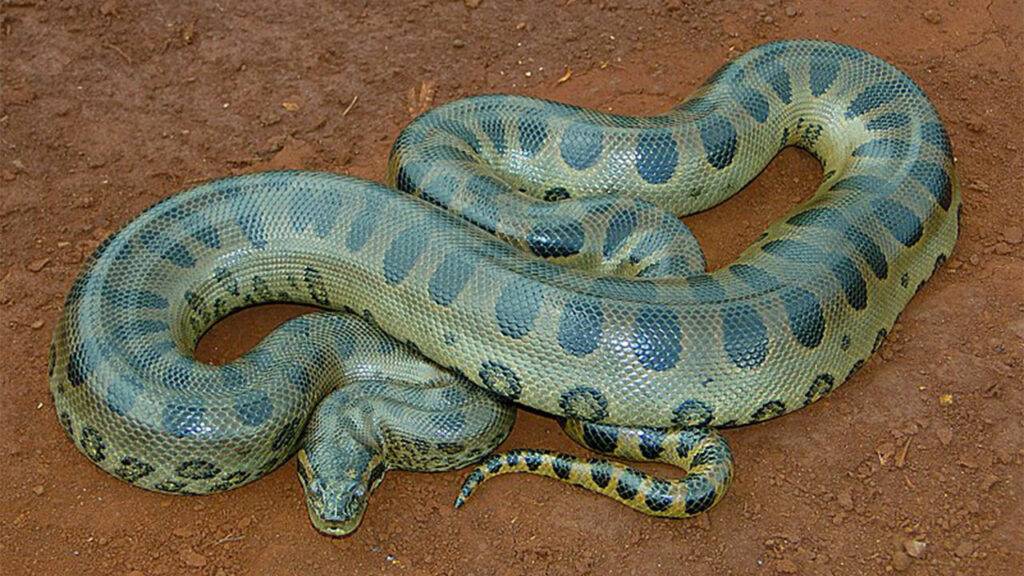In the lush landscapes of South America and the Caribbean, a colossal creature silently slithers through the waterways—the Green Anaconda (Eunectes murinus).
Known as the giant anaconda, emerald anaconda, or common water boa, this majestic serpent stands as the largest, heaviest, and second-longest snake globally. Let’s dive into the intriguing world of the Green Anaconda, exploring its size, habitat, and a surprising revelation of a newfound species.

The Green Anaconda
The green anaconda, scientifically known as Eunectes murinus, is a spectacular boa species that calls South America and the Caribbean island of Trinidad its home. Often referred to as the giant anaconda, emerald anaconda, common anaconda, common water boa, or southern green anaconda.
This magnificent serpent is not only the largest but also the heaviest snake globally, claiming the title second only to the reticulated python in length
Being a constrictor, the Green Anaconda doesn’t rely on venom to subdue its prey. Instead, it employs a unique hunting strategy, wrapping its powerful body around its target and squeezing until the victim ceases to breathe. These constrictors, including the Green Anaconda, are non-venomous, showcasing nature’s diverse adaptations for survival.
Green Anaconda Size
The Green Anaconda, a member of the Eunectes genus, captivates with its sheer size and strength. According to the National Zoo, it can reach an astounding length of 30 feet (9 meters) and weigh an impressive 550 pounds (227 kilograms). To put this into perspective, envision five ten-year-olds lying head to foot—roughly the length of this colossal serpent.
Delving into the historical aspect, the Green Anaconda has a storied existence dating back to the Late Pleistocene, as evidenced by fossils found in the Gruta do Urso locality.
Historically, four anaconda species, including the Green Anaconda, were recognized as true behemoths of the reptile world. The largest females could grow to more than seven meters long and weigh over 250 kilograms.
New Anaconda Species Northern Green Anaconda
In the realm of serpentine wonders, a recent discovery has added a new dimension to the narrative—the Northern Green Anaconda (Eunectes Nakajima). According to this newly identified species shares the title of one of the largest, heaviest, and longest snakes globally.
Found in Ecuador, Colombia, Venezuela, Trinidad, Guyana, Suriname, and French Guiana, the Northern Green Anaconda distinguishes itself genetically from its southern counterpart.
The revelation of the Northern Green Anaconda in 2024, as reported by National Geographic, sheds light on the evolutionary divergence of the Green Anaconda almost 10 million years ago. This distinct species, named Eunectes akayima, showcases the rich biodiversity within the Eunectes genus.
Largest Snake in the World
Green anacondas are the world’s heaviest snakes, and among the longest. The green anaconda has long been considered one of the Amazon’s most formidable and mysterious animals. Our new research upends scientific understanding of this magnificent creature, revealing it is actually two genetically different species.
The Green Anaconda’s imposing size has long fascinated researchers and nature enthusiasts alike. As National Geographic Maps illustrate, these giant snakes navigate through extensive territories, showcasing their dominance in the Amazon’s intricate ecosystem.
Conclusion
In the realm of serpents, the Green Anaconda stands as a true marvel of nature. Its colossal size, non-venomous hunting technique, and recent revelation of a new species highlight the diversity within the Eunectes genus.
As we continue to explore and understand these majestic creatures, the Amazon’s mysterious waters conceal more secrets, awaiting discovery by intrepid researchers and nature enthusiasts alike.


